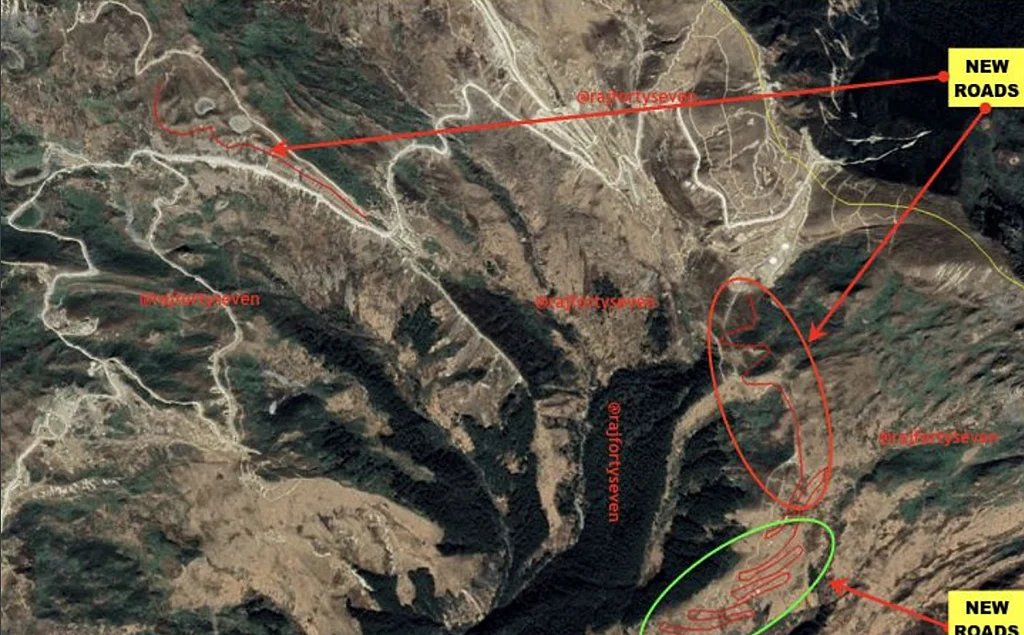Chinese build-up in southern Doklam continues ahead of Modi-Xi summit
China’s build-up in the southern part of the Doklam Plateau continues unabated. Coupled with a surge of pro-China sentiment among younger Bhutanese, this presents a headache for India

China’s build-up in the southern part of Doklam Plateau at the tri-junction with India and Bhutan continues, satellite images taken on April 25 through Google Earth have revealed. The previous images of the Doklam Plateau, taken in October last year, showed that China had developed a “military complex” 10 metres from where the Indian and Chinese troops had come face-to-face during the 73-day standoff last year.
The recent development comes ahead of a crucial meeting between Prime Minister Narendra Modi and Chinese President Xi Jinping through April 27 and 28 in the central Chinese city of Wuhan.

Discussions on the outstanding boundary dispute is an important issue expected to come up between the two leaders. The Chinese vice-foreign minister Kong Xuanyou on Tuesday billed the upcoming talks as “heart-to-heart” discussions. “The (Doklam) stand-off reflected the somewhat lack of mutual trust between the two countries,” Kong had commented on Tuesday.
However, the new Chinese road construction activity casts a shadow on the summit between the two leaders. Already, there have been reports of Chinese build-up on the Doklam Plateau since the 73-day standoff between the Indian and Chinese armies ended on August 28 last year.
“The Chinese have not withdrawn from Doklam. But there has been a dramatic change in the ground situation. Now, there are communication towers, security shelters and more Chinese military personnel,” former Indian Ambassador to Bhutan VP Haran explained at an event ‘China Factor in Bhutan’ in New Delhi on April 25. “While most of the activity has been taking place on the northern part of the Doklam Plateau, there have been reports of incursions into Bhutanese territory on the south,” Haran added.
The former Indian diplomat took Chinese vice foreign minister Kong Xuanyou’s positive remarks with a pinch of salt, saying that it was Beijing who had violated the existing status quo agreements on the boundary issue with both Bhutan and India. “How can he say that Doklam happened because of mutual lack of trust?” Haran questioned.
Haran noted that an agreement in 2012 between China’s and India’s special representatives stated that disputes at the tri-junction would be decided in consultation with the third countries. “Did the Chinese consult Bhutan before beginning the road construction activity on June 16 in Doklam in the lead-up to standoff last year? No,” the former diplomat noted.
“The Chinese have not withdrawn from Doklam. But there has been a dramatic change in the ground situation. Now, there are communication towers, security shelters and more Chinese military personnel,” former Indian Ambassador to Bhutan VP Haran explained at an event ‘China Factor in Bhutan’ in New Delhi on April 25
Haran highlighted that a road on the southern part of Doklam would provide easy access for China to the Jhamperi Ridge, which overlooks the Siliguri corridor in India. “Beyond the Jhamperi ridge lies a deep gorge. But one is able to view India’s sensitive strategic installations and transport movement from Jhamperi, which China has been apparently trying to control,” Haran said.
In fact, China has offered Bhutan 300 square kilometre of its territory in return for over 495 square kilometres of Bhutanese territory. The southern part of Doklam is part of the land that Beijing wants in the land swap deal. So far, Bhutan has refused the Chinese proposal.
However, in what may be a worrying sign for India, Bhutan has of late been viewed as ignoring incursion attempts by China, which have become more frequent over the last few years.
“Protests from Bhutan have become less frequent even though incursions from China have been consistently increasing. They don’t want to rattle the Chinese ego,” Haran remarked.
Growing pro-China sentiment in Bhutan
Increased Chinese assertiveness is not India’s only headache in Bhutan, which has also seen a surge in the number of people, especially younger ones, who want closer economic ties with China.
“The younger generation see economic merit in having closer economic relations with China, as compared to the older people who are more disposed towards India’s view,” Haran, who served as India’s envoy to Bhutan between 2012 and 2014, said.
“Even the current king Jigme Khesar and the prime minister are in favour of closer relations with China. It is just his father, the fourth king Jigme Singye, who are more cautious in opening up to China,” the former envoy said.
Under the Bhutanese constitution, the king oversees national security and foreign affairs. “There is an understanding between the father and the son, under which Singye still looks after defence and foreign relations, while the son takes care of domestic politics,” Haran noted.
“While there are no direct trade relations between Bhutan and China, 75 to 80% of goods in Bhutanese market are Chinese-made,” Haran said. “Most of these goods are routed through India and south-east Asian countries,” he added.
Haran mentioned that last year’s standoff in Doklam witnessed a further growth of the anti-India lobby in the Himalayan kingdom, which until then kept a low-profile. He said, “Before, people raising anti-India voices in the media and public space kept a low profile. They have started to come out in the open and have become more brazen since Doklam happened.
Follow us on: Facebook, Twitter, Google News, Instagram
Join our official telegram channel (@nationalherald) and stay updated with the latest headlines